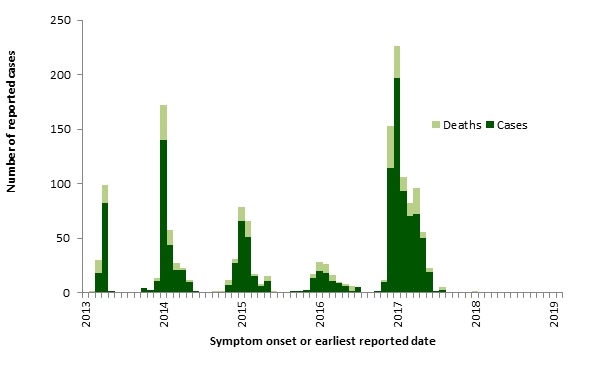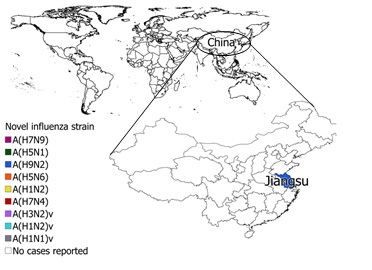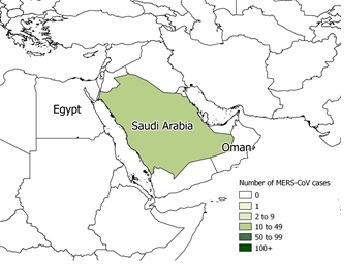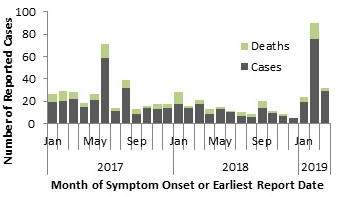Human Emerging Respiratory Pathogens Bulletin - Issue 27, March 2019
Download the alternative format
(PDF format, 818 KB, 2 pages)
Organization: Public Health Agency of Canada
Published: 2019-04-24
Monthly situational analysis of emerging respiratory diseases affecting humans (data to March 31, 2019)
In this bulletin
- Avian Influenza Updates
- Swine Influenza Updates
- Middle East Respiratory Syndrome Coronavirus Updates (MERS-CoV)
| Novel influenzaTable 1 Footnote 1 | Cumulative Case CountTable 1 Footnote 2 | Deaths | Case Fatality Rate %Table 1 Footnote 3 |
|---|---|---|---|
| A(H7N9) | 1,567 | 615 | 39% |
| A(H5N1) | 878 | 460 | 52% |
| A(H9N2) | 51 | 1 | 2% |
| A(H5N6) | 23 | 15 | 65% |
| A(H7N4) | 1 | 0 | 0% |
| H3N2v | 435 | 1 | <1% |
| H1N2v | 26 | 0 | 0% |
| H1N1v | 22 | 0 | 0% |
| A(H1N2)Table 1 Footnote 4 | 2 | 0 | 0% |
| MERS-CoVTable 1 Footnote 1 | Cumulative Case CountTable 1 Footnote 2 | Deaths | Case Fatality Rate %Table 1 Footnote 3 |
| Global Case Count | 2,406 | 828 | 34% |
| Saudi Arabia | 2,015 | 751 | 37% |
|
|||
Avian Influenza Updates
Avian influenza A(H7N9)
In March 2019, no new cases of H7N9 have been reported. The most recent case occurred in a 59-year-old woman in February 2018 in China. After emergence in 2013, and until 2017, case increases occurred annually, peaking in December/January of each year. However, H7N9 activity has remained low since the end of the fifth wave (September 2017). Only three cases were reported during wave 6 (October 2017 to September 2018), with no cases reported since [Figure 1]. This decrease in cases may be attributable to China's introduction of a bivalent vaccine against influenza H5 and H7 in poultry, which was deployed after the large number of human cases observed during wave 5. Globally, since 2013, a total of 1567 cases including at least 615 deaths have been reported. Two travel-related cases were reported in Canada in January 2015.
Figure 1. Temporal distribution of human infection with avian influenza A(H7N9), globally, January 1st, 2013 – March 31, 2019.

Note: Graph was prepared by the Centre for Immunization and Respiratory Infectious Diseases (CIRID) using data from the latest WHO Monthly Influenza at the Human-Animal Interface Risk Assessment. This graph reflects data available through these risk assessments as of March 31, 2019.
Text description
| Year | Month | Cases | Deaths |
|---|---|---|---|
| 2016 | Jun | 2 | 0 |
| Jul | 4 | 0 | |
| Aug | 0 | 0 | |
| Sep | 0 | 0 | |
| Oct | 2 | 0 | |
| Nov | 10 | 2 | |
| Dec | 114 | 39 | |
| 2017 | Jan | 197 | 29 |
| Feb | 93 | 13 | |
| Mar | 70 | 12 | |
| Apr | 72 | 24 | |
| May | 50 | 6 | |
| Jun | 19 | 4 | |
| Jul | 2 | 0 | |
| Aug | 3 | 2 | |
| Sep | 1 | 0 | |
| Oct | 0 | 0 | |
| Nov | 0 | 0 | |
| Dec | 1 | 0 | |
| 2018 | Jan | 1 | 1 |
| Feb | 1 | 0 | |
| Mar | 0 | 0 | |
| Apr | 0 | 0 | |
| May | 0 | 0 | |
| June | 0 | 0 | |
| July | 0 | 0 | |
| Aug | 0 | 0 | |
| Sep | 0 | 0 | |
| Oct | 0 | 0 | |
| Nov | 0 | 0 | |
| Dec | 0 | 0 | |
| 2019 | Jan | 0 | 0 |
| Feb | 0 | 0 | |
| Mar | 0 | 0 |
Avian Influenza A(H5N1)
The most recent case of H5N1 was reported in September 2017 in Indonesia. The case was associated with poultry exposure. A total of 878 cases including 460 deaths have been reported globally since 1997. One fatal travel-related case of H5N1 was reported in Canada in January 2014. No secondary transmission in Canada was reported.
Avian Influenza A(H5N6)
The most recent case of H5N6 was reported in November 2018 in China. The source of exposure was unknown. There have been a total of 23 cases, including 15 deaths, reported globally since 2014, all in China.
Avian Influenza A(H7N4)
On February 14, 2018, the WHO was notified of the first known human case of H7N4. The case was associated with poultry exposure. No cases have been reported since.
Avian Influenza A(H9N2)
In March 2019, China reported one new case of H9N2. The case was a 9-year-old boy from Jiangsu province, who had symptom onset on March 15 and was hospitalized. The current clinical status is unknown. The patient reported contact with poultry. A total of 51 cases, including 1 death, have been reported worldwide since 1998.
Swine Influenza Updates
Swine Origin Influenza A(H3N2)v
The most recent case of swine origin influenza H3N2v was reported in June 2018 in the United States. The case reported exposure to swine at an agricultural fair. A total of 435 cases, including 1 death, have been reported globally since 2011. One locally-acquired case of H3N2v was reported in Canada in December 2016.
Swine Origin Influenza A(H1N2)v
The most recent case of swine origin influenza H1N2v was reported in August 2018 in the United States. The case reported exposure to swing at an agricultural fair. A total of 26 confirmed cases of H1N2v have been reported in the United States since 2005. Most of the reported cases resulted in mild illness.
Swine Origin Influenza A(H1N1)v
The most recent case of swine origin influenza H1N1v was reported in January 2018 in Switzerland. The case was associated with swine exposure. A total of 22 cases have been reported globally since 2005. H1N1v infection is associated with mild illness.
Figure 2. Spatial distribution of human cases of avian and swine influenza reported globally in March 2019.

Note: Map was prepared by the Centre for Immunization and Respiratory Infectious Diseases (CIRID) using data from the latest WHO Monthly Influenza at the Human-Animal Interface Risk Assessment. This map reflects data available through these risk assessments as of March 31, 2019.
Text description
The spatial distribution of avian and swine influenza human cases in March 2019 has been displayed in Figure 2. 5 One avian influenza A(H1N2) has been reporten in March 2019 from China, in Jiangsu Province.
Middle East Respiratory Syndrome Coronavirus Updates
Middle East Respiratory Syndrome Coronavirus (MERS-CoV)
In March 2019, 32 new cases of MERS-CoV, including 3 deaths, were reported in Saudi Arabia (Figure 3): a decrease from the 76 cases reported in February. Approximately 69% (22/32) of these cases were male, the median age was 51 years (range: 22-85 years) and 34% (11/32) reported exposure to camels. Six cases this month were associated with the hospital outbreak in Wadi Aldawasir city that first reported to the WHO on February 6, 2019. To date, 57 MERS-CoV cases have been associated with this outbreak and most were due to healthcare exposure. A total of 2406 laboratory-confirmed cases of MERS-CoV, including 828 deaths, have been reported globally since 2012 by the WHO and the Kingdom of Saudi Arabia (Figure 4). No cases have been reported in Canada.
Figure 3. Spatial distribution of human cases of MERS-CoV reported in March 2019.

Note: Map was prepared by the Centre for Immunization and Respiratory Infectious Diseases (CIRID) using data from the latest WHO Disease Outbreak News and Saudi Arabia's Ministry of Health. This map reflects data available through these risk assessments as of March 31, 2019.
Text description
The spatial distribution of reported MERS cases in March 2019 has been displayed in Figure 3. A total of 32 cases have been reported in March, all from Saudia Arabia.
Figure 4. Temporal distribution of human cases of MERS-CoV reported to the WHO, globally, by month and year, January 1, 2017 – March 31, 2019.

Note: Graph was prepared by the Centre for Immunization and Respiratory Infectious Diseases (CIRID) using data from the WHO Disease Outbreak News and Saudi Arabia's Ministry of Health. This graph reflects data available as of March 31, 2019.
Text description
| Year | Month | Cases | Deaths |
|---|---|---|---|
| 2017 | Jan | 19 | 7 |
| Feb | 20 | 9 | |
| Mar | 22 | 6 | |
| Apr | 15 | 3 | |
| May | 21 | 5 | |
| Jun | 59 | 12 | |
| Jul | 11 | 3 | |
| Aug | 32 | 7 | |
| Sep | 8 | 5 | |
| Oct | 14 | 2 | |
| Nov | 13 | 4 | |
| Dec | 14 | 3 | |
| 2018 | Jan | 17 | 11 |
| Feb | 14 | 2 | |
| Mar | 17 | 4 | |
| Apr | 8 | 5 | |
| May | 13 | 2 | |
| June | 10 | 1 | |
| July | 7 | 3 | |
| August | 6 | 2 | |
| Sep | 14 | 6 | |
| Oct | 9 | 2 | |
| Nov | 7 | 1 | |
| Dec | 5 | 0 | |
| 2019 | Jan | 19 | 5 |
| Feb | 76 | 14 | |
| Mar | 29 | 3 |
Page details
- Date modified: